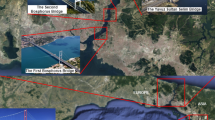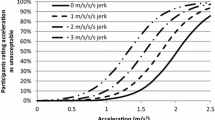Abstract
This research demonstrates how to analyse the dynamic response of a high-speed train moving over consecutive bridges. The authors explain in detail how to apply the uncoupled iterative method to consecutive bridges, by deriving the complete motion history for one bridge segment at a time, using the solution of the train as an initial condition for the next bridge. This algorithm is a highly cost-effective approach to analysing the train-bridge interaction for a high speed railway (HSR). The authors perform this analysis on two existing bridges: a simply supported Taiwan HSR bridge, and a three-span continuous Korea HSR bridge. The results show that both types of bridges are capable of supporting HSR trains at speeds up to 400 km/h with negligible carbody displacements and accelerations. This speed is greater than the current service speed of 300 km/h.
Similar content being viewed by others
References
Biondi, B., Sofi, G, and Muscolino, A. (2005). “A substructure approach for the dynamic analysis of train-track-bridge system.” Computers & Structures, Vol. 83, pp. 2271–2281, DOI: 10.1016/j.compstruc.2005.03. 036.
Delgado, R. M. and Santos, S. M. (1997). “Modelling of railway bridge-vehicle interaction on high speed tracks.” Computers & Structures, Vol. 63, pp. 511–523, DOI: 10.1016/S0045–7949(96)00360–4.
Dumitruiu, M. (2012). “Influence of the suspension damping on ride comfort of passenger railway vehicles.” UPB Scientific Bulletin, Series D: Mechanical Engineering, Vol. 74, pp. 75–90.
Eurocode 0 (2005). Basis of structural design, BS EN: 1990:2002 +A1, European Committee for Standardization, Brussel, Belgium.
Eurocode 1 (2003). Actions on structure: Part 2: Traffic load on bridge, BS EN: 1991–2, European Committee for Standardization, Brussel, Belgium.
Gu, G (2010). Dynamic impact load to railway bridges induced by structural response and track irregularities, PhD Thesis, Newcastle University, Newcastle upon Tyne, UK.
Gu, G (2015). “Resonance in long-span railway bridges carrying TGV trains.” Computers & Structures, Vol. 152, pp. 185–199, DOI: 10.1016/j.compstruc.2015.02.0020045–7949.
Gu, G and Choi, J. (2013). “The dynamic response of rail support.” Vehicle System Dynamic, Vol. 51, pp. 798–820, DOI: 10.1080/00423114. 2013.778415.
Gu, G and Franklin, F. J. (2010). “Dynamic impact loads to railway bridges induced by track irregularities-case study.” Vehicle System Dynamic, Vol. 48, pp. 1097–1113, DOI: 10.1080/00423110903406672.
Gu, G., Kapoor, A., and Lilley, D. M. (2008). “Calculation of dynamic impact loads for railway bridges using a direct integration method.” Proc. IMechE, Part F: J. Rail and Rapid Transit, Vol. 222, pp. 385–398, DOI: 10.1243/09544097JRRT189.
Gu, G., Lilley, D. M., and Frankly, F. J. (2010). “A structural articulation method for assessing railway bridges subject to dynamic impact loading from track irregularities.” Vehicle System Dynamic, Vol. 48, pp. 1077–1095, DOI: 10.1080/00423110903337273.
Gulvanessian, H., Calgaro, J. A., and Holick, M. (2012). Guide to Eurocode 0: Basis of structural design (2nd Ed), ICE Publishing, London, UK.
He, X. and Nan, Z. (2005). “Dynamic analysis of railway bridge under high-speed trains.” Computers and Structures, Vol. 83, pp. 1891–1901, DOI: 10.1016/j.compstruc.2005.02.014.
ISO 2631-1 (1997). Mechanical vibration and shock — Evaluation of human exposure to whole-body vibration — Part 1: General requirements, ISO 2631–1, International Organization for Standardization, Geneva, Switzerland.
Knothe, L. and Grassie, S. L. (1993). “Modelling of railway track and vehicle/track interaction at high frequencies.” Vehicle System, Dynamics, Vol. 22, pp. 209–262, DOI: 10.1080/00423119308969027.
Kouroussis, G., Verlinden, O., and Conti, C. (2010). “Free field vibrations caused by high-speed lines: Measurement and time domain simulation.” Soil Dynamics and Earthquake Engineering, Vol. 31, pp. 692–707, DOI: 10.1016/j.soildyn.2010.11.012.
LUSAS Ltd. (2018). LUSAS Manual, LUSAS Ltd, Surrey, UK.
Network Rail (2004). The structural assessment of underbridges, RT/ CE/C/025, Network Rail company standard, London, UK.
Nielsen, J. C. A. and Abrahamsson, T. J. S. (1992). “Coupling of physical and modal components for analysis of moving non-linear dynamic systems on general beam structures.” Numerical Method in Engineering, Vol. 33, pp. 1843–1859, DOI: 10.1002/nme.1620330906.
UIC Code 776-1R (2006). Loads to be considered in railway bridge design, UIC Code 776–1R, International Union of Railways, Paris, France.
UIC Code 776–2R (2006). Bridges for high and very high speeds, UIC Code 776–2R, International Union of Railways, Paris, France.
UIC Code 776-3R (2006). Deformation of bridges, UIC Code 776–3R, International Union of Railways, Paris, France.
Wang, W. and Li, G. (2012). “Development of high-speed railway vehicle derailment simulation–Part II: Exploring the derailment mechanism.” Engineering Failure Analysis, Vol. 24, pp. 93–111, DOI: 10.1016/j.engfailanal.2012.01.013.
Wiriyachai, A., Chu, K. H., and Garg, V. K. (1982). “Bridge impact due to wheel and track irregularities.” Journal of the Engineering Mechanics Division, Vol. 108, pp. 648–666.
Yange, F. H. and Founder, G. A. (1996). “An iterative solution method for dynamic response of bridge-vehicles systems.” Earthquake Engineering & Structural Dynamics, Vol. 25, pp. 195–215, DOI: 10.1002/(SICI) 1096–9845(199602)25:2<195::AID-EQE547>3.0.CO;2-R.
Zhang, N. and Xia, H. (2013). “Dynamic analysis of coupled vehicle-bridge system based on inter-system iteration method.” Computers and Structures, Vol. 114, pp. 26–34, DOI: 10.1016/j.compstruc.2012. 10.007.
Acknowledgements
The authors thank Midas Information Technology Co., Ltd for financial support of this project.
Author information
Authors and Affiliations
Corresponding author
Rights and permissions
About this article
Cite this article
Gu, G., Yang, F. Dynamic Response of High Speed Train Moving on Consecutive Bridges. KSCE J Civ Eng 23, 4047–4062 (2019). https://doi.org/10.1007/s12205-019-2028-4
Received:
Revised:
Accepted:
Published:
Issue Date:
DOI: https://doi.org/10.1007/s12205-019-2028-4




